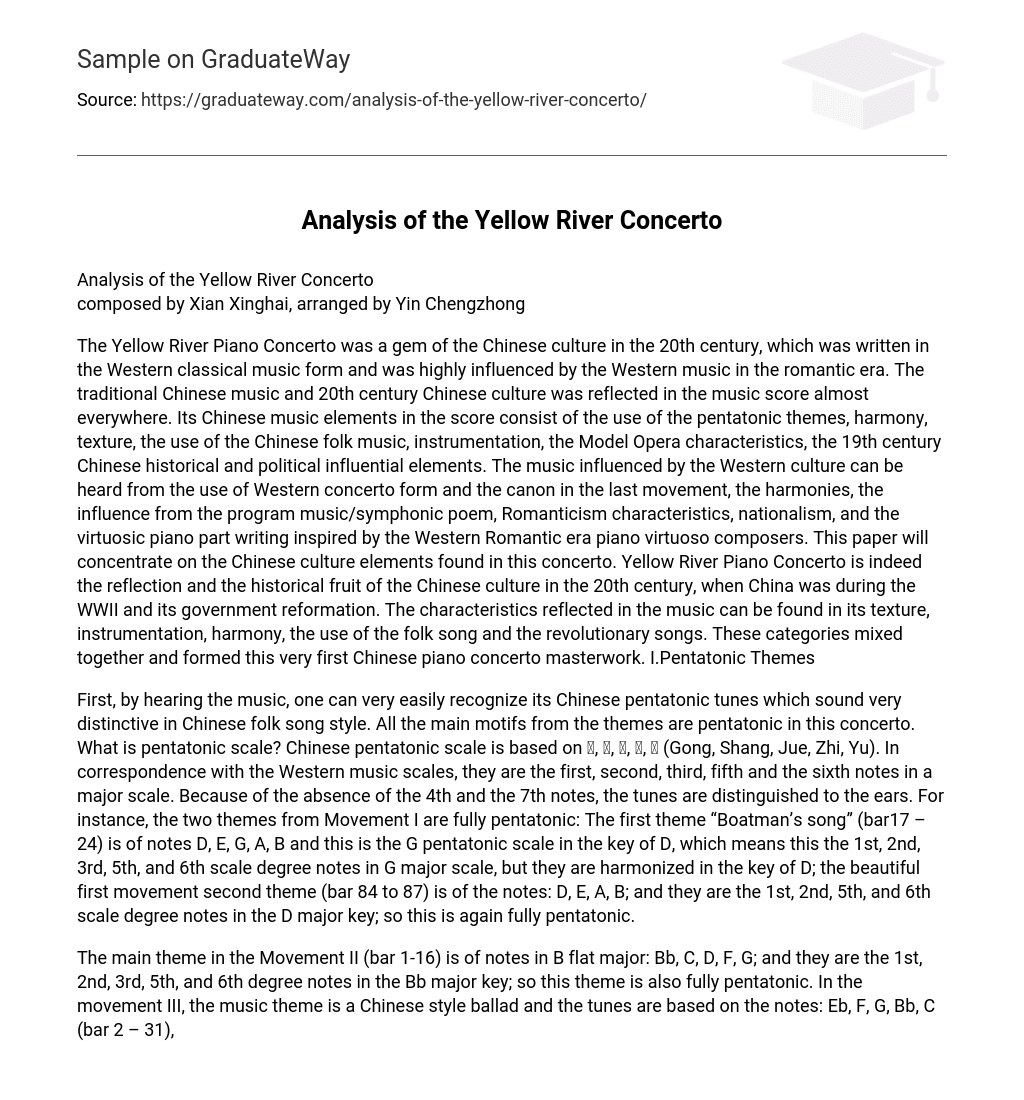The Yellow River Piano Concerto, a remarkable piece of the Chinese culture in the 20th century, incorporated elements of both traditional Chinese music and Western classical music. Reflecting the influence of Western music during the romantic era, the concerto embraced various aspects of Chinese music and culture. Notably, it featured pentatonic themes, harmony, texture, Chinese folk music, specific instrumentation, characteristics reminiscent of Model Opera, and elements of 19th century Chinese history and politics. At the same time, the concerto showcased Western influences through its use of the concerto form and canon in the final movement. It also incorporated harmonies influenced by program music and symphonic poems, as well as characteristics of Romanticism. Additionally, nationalistic themes were introduced, while the virtuosic piano part was inspired by renowned Western Romantic-era piano composers.
This paper will discuss the Chinese cultural elements present in the Yellow River Piano Concerto. The concerto serves as a reflection and historical representation of Chinese culture during the 20th century, a time when China was experiencing World War II and undergoing governmental reforms. The characteristics of the music can be observed in its texture, instrumentation, harmony, use of folk and revolutionary songs. These categories blend together to create the groundbreaking masterpiece that is the Yellow River Piano Concerto.
I. Pentatonic Themes
When listening to the music, it is easy to recognize the distinct Chinese pentatonic melodies found in Chinese folk songs. The main motifs in this concerto are all pentatonic. In Chinese music, the pentatonic scale is based on the notes 宫, 商, 角, 徵, 羽 (Gong, Shang, Jue, Zhi, Yu). These notes correspond to the first, second, third, fifth and sixth notes of a major scale in Western music scales. Because the fourth and seventh notes are not included in these tunes, they have a unique sound.
For instance,
both themes in Movement I consist solely of pentatonic scales: The first theme “Boatman’s song” (bar 17-24) features the notes D,E,G,A,B which form a G pentatonic scale within the key of D. This means that these notes are harmonized within the key of D but represent degrees one through six of G major scale.
In similar fashion,
the beautiful second theme of movement one (bar 84-87) comprises the notes D,E,A,B which represent degrees one through two,five and six respectively from the key signature of D major. Thus,this particular theme is also fully pentatonic.
In Movement II (bars 1-16), the main theme is fully pentatonic, consisting of notes in Bb major: Bb, C, D, F, G. These notes are the 1st, 2nd, 3rd, 5th, and 6th degrees of the Bb major scale. In Movement III (bars 2-31), a Chinese-style ballad with tunes based on the notes Eb, F, G, Bb, C is introduced. These notes form the E-flat pentatonic scale in E-flat major key. Moving to Movement IV (bars 25-26), the main theme includes a sequence where the motif C#, C#, E, A from bars 23-24 is transformed up a major second interval to create the sequence F#, F#, D,B,B. The inclusion of the fourth scale degree note does not affect its pentatonic sound as it is initially part of this sequence within the main pentatonic motif. Additionally, in bars 27 and 29 it functions as a passing note. Overall,the main theme lasts from bar19-49 and apart from these two instances mentioned earlier,it is entirely composed using A pentatonic scale notes which are A,B,C#,E,and F#. These notes belong to A major key.
Although this piece incorporates pentatonic themes, the harmonies utilized are reminiscent of Western classical music. However, in certain sections and movements, the harmonies rely on pentatonic scales, resulting in a unique sound distinct from Western classical music. Some of the Western harmonies employed include perfect cadences at the conclusion of each phrase and section, applied chords (such as V/V) to anticipate and enhance V – I cadences, borrowing chords from the minor key (e.g. I, bII, v, bVII), and utilizing interrupted progressions (V/vi to IV) for added musical variety. The composer has skillfully integrated these harmonies into a very distinctive Chinese style by tentatively avoiding notes outside of the pentatonic scale, incorporating pedal notes with non-harmonic notes above using the fundamental note of a primary chord, infusing drone elements, and employing repetitive harmonic patterns to a significant degree.
The concerto’s texture is reminiscent of Chinese model opera, with sections played in unison (homophonic texture) and others featuring themes/motifs accompanied by drones (monophonic texture). The piece includes repetitive motifs (a characteristic of Chinese model opera), chromatic passages, and virtuosic piano techniques commonly found in Western Romantic-era music.
The model operas, promoted by Chinese politicians in the 20th century, were a historical art form primarily aimed at farmers and factory workers. These operas were designed to easily connect with the audience, educate them about political philosophy, and achieve political objectives. The essence of model operas always embodied upright principles and intense drama, focusing on themes of national defense and the lower class. This particular piece also reflects these characteristics through its incorporation of folk songs, dramatic elements, and sound effects related to warriors. Notably, it includes the song “东方红” to praise Chairman Mao and reflect the historical context.
Overall, this concerto successfully combines Western music influences with Chinese heritage, resulting in a piece that deeply resonates with both educated and non-educated Chinese individuals. It has had such a significant impact that it became a benchmark composition in 20th century China, leading to the government allowing musicians to return to their instruments instead of being assigned farm work. This concerto exemplifies the seamless fusion of two distinct musical cultures and continues to be warmly received by audiences worldwide.





